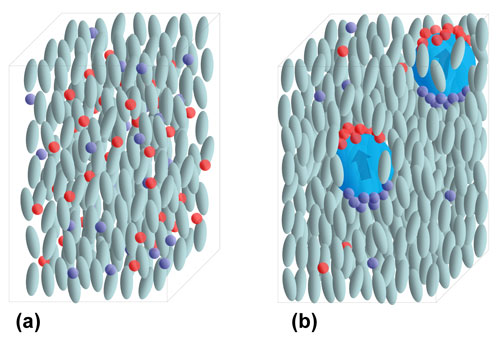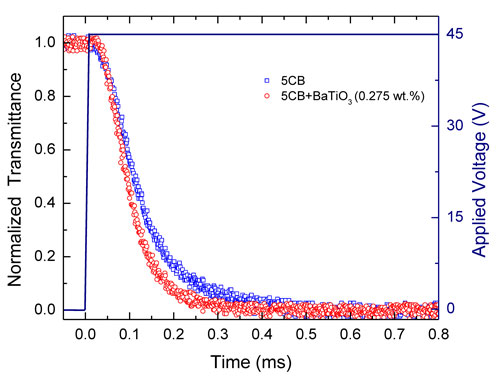| Posted: Oct 16, 2014 | |
Cleansing the ionic impurities in LCDs with nanoparticles(Nanowerk Spotlight) Image retention in liquid crystal displays (LCDs) is often referred to as image sticking or image persistence. As with 'burn-in' on phosphor-based displays (e.g. plasma TV), image retention is a phenomenon where a faint outline – or 'ghosting' – of a previously displayed fixed or semi-fixed image remains visible on the LCD screen even when the image is changed. |
|
| In a nematic LCD (in the nematic LC phase the molecules are oriented in parallel but not arranged in well-defined planes) electric fields are used to switch the pixels on and off by switching the nematic director from a planar to a vertical configuration. | |
| "Almost all liquid crystals contain mobile ions that influence the LCs' field-induced switching phenomena," Rajratan Basu, an Assistant Professor in the Department of Physics at the United States Naval Academy, explains to Nanowerk. "When an electric field is applied to switch the pixels, the positive and negative ions are separated at the opposite electrodes. This ion-separation results in an internal electric field across the pixels in the opposite direction of the external applied field – which affects the switching behavior of the LC." | |
| If a static image remains on the display for an extended period of time, then even when the external field is removed, the internal field due to the ion-separation remains present for some time,leading to image sticking. | |
| "These ions are generated as impurities during the LC’s production process," says Basu. "They can also stem from the LC cell’s polymer alignment layers, the surrounding glue of the cell, and the filling process." | |
| Since image sticking and flickering effects are caused by the ion transport, LCD manufacturers make a lot of efforts towards the purification of the LCs from unwanted ions. | |
| Basu and his student Midshipman Alfred Garvey now have developed a method to reduce the presence of excess ions by doping LCDs with BaTiO3 ferroelectric nanoparticles (FNPs). | |
| They report their findings in the October 15, 2014 online edition of Applied Physics Letters ("Effects of ferroelectric nanoparticles on ion transport in a liquid crystal"). | |
 |
|
| Figure 1: A schematic illustration of the presence of mobile ions and BaTiO3 FNPs in the nematic phase. The small spheres represent the ions, the ellipsoids represent LC molecules, and the big spheres represent the FNPs. (a) Random distribution of free ions in a nematic phase. (b) FNPs’ ion trapping process in a nematic phase. (Image: Dr. Basu) | |
| As Basu and Garvey describe in their paper, BaTiO3 FNPs, with a radius of 25 nm, possess a high spontaneous permanent polarization which results in a strong electric field, in the order of 1010 V m-1, close to their surfaces. | |
| "Consequently, these strong local fields can trap some of the mobile ions near the FNPs, decreasing the overall free-ion concentration in the LC," notes Basu. | |
| The two researchers observed that a 0.00275 weight fraction of FNPs reduced the free-ion concentration by 50%. This ion-trapping process by the FNPs is schematically shown in Figure 1 above. | |
| Rotational viscosity of an aligned LC represents an internal friction among LC molecules during the field-induced switching process. The presence of free ions can greatly enhance this internal friction, enhancing rotational viscosity of the LC. | |
| The two scientists therefore performed experiments to measure rotational viscosity for the pure LC and LC+FNP hybrids to understand if the reduction of ions had any consequent effects on it. | |
| "We found that the reduction of free ions has coherent impacts on the LC's conductivity, rotational viscosity, and electric field-induced nematic switching," says Basu. | |
| Figure 2 below shows a faster electro-optical response of an LC+FNP hybrid due to the presence of fewer mobile ions and a reduction of rotational viscosity. | |
 |
|
| Figure 2: Left axis: Normalized transmittance as function of time for 5CB (LC) and 5CB+BaTiO3 (0.275 wt. %) after the voltage is turned on. Right axis: The lines represent the applied voltage profile across the cell as a function of time. Note, as the applied voltage is turned on to 45 V at t = 0, the transmittance starts to drop. (Image: Dr. Basu) | |
| Basu and Garvey, however, note that when the FNP-concentration becomes significantly large in the LC (e.g. 0.00525 weight fraction), they no longer effectively trap ions because of their nanoscale aggregations that diminish the effective electric fields and exposed surface area of individual FNPs. | |
| These results are important for developing novel methods of purifying LCs from excess ions without additional chemical synthesis. | |
| This work was supported by the Office of Naval Research (Division 312: Electronics Sensors and Network Research) under Award No. N0001414WX20791. | |
 By
Michael
Berger
– Michael is author of three books by the Royal Society of Chemistry:
Nano-Society: Pushing the Boundaries of Technology,
Nanotechnology: The Future is Tiny, and
Nanoengineering: The Skills and Tools Making Technology Invisible
Copyright ©
Nanowerk LLC
By
Michael
Berger
– Michael is author of three books by the Royal Society of Chemistry:
Nano-Society: Pushing the Boundaries of Technology,
Nanotechnology: The Future is Tiny, and
Nanoengineering: The Skills and Tools Making Technology Invisible
Copyright ©
Nanowerk LLC
|
|
|
Become a Spotlight guest author! Join our large and growing group of guest contributors. Have you just published a scientific paper or have other exciting developments to share with the nanotechnology community? Here is how to publish on nanowerk.com. |
|
